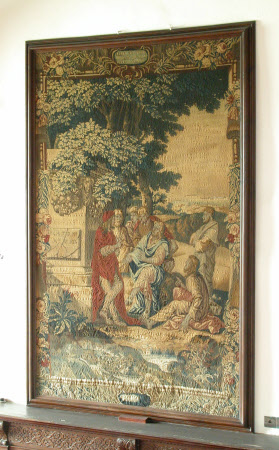The School of Plato
possibly Mortlake Tapestry Manufactory
Category
Tapestries
Date
circa 1680 - circa 1700
Materials
Tapestry, wool and silk, 8 warps per cm
Measurements
3.66 m (H); 1.83 m (W)
Place of origin
England
Order this imageCollection
Chirk Castle, Wrexham
NT 1171322
Summary
Tapestry, wool and silk, 8 warps per cm, The School of Plato, English, possibly Mortlake, c. 1680-1700. A group of philosophers debating in a landscape by an overgrown stone altar decorated with rams' heads, which is inscribed 'PLATONI / Ao. VXII'. Plato, dressed in red, stands by the altar gesturing as he speaks, while his friends and disciples stand and sit around him listening and talking. There are borders on all four sides of the tapestry composed of scrolling stone forms with garlands of flowers arranged over them, and blue cartouches at the centre top and bottom.
Full description
The setting for the gathering of philosophers is the grove known as the Academy, outside the walls of Athens, where Plato lived and conducted debates (Diogenes Laertius 1925, 3.7). The philosopher Diogenes of Sinope (412/403–324/321 BC) was considered, along with Antisthenes, the founder of Cynicism. His nickname ‘Cynic’, literally ‘doglike’, reflects the highly unconventional lifestyle he lived and advocated. Diogenes re-evaluating mankind’s relation to both nature and civilization, and redefined the individual’s freedom and self-sufficiency. None of Diogenes's written works survives, but he quickly became an established literary figure and numerous anecdotes arose relating to his eccentricities. The tapestry at Chirk comes from a series of seven scenes from the life of Diogenes, with the subjects 'Plato's Academy', 'Diogenes in Meditation', 'Diogenes Beside his Barrel', 'Diogenes Washing Plants', 'Diogenes Discarding his Cup', 'Diogenes Writing on the Wall' and 'Alexander Visiting Diogenes'. The subjects were taken from Diogenes Laertius's 'The Lives of the Philosophers', written in the 3rd century AD and the main source for Diogenes's life. The text was published in Latin in London in 1664 (see Diogenes Laertius 1925. The designs for four of the tapestries, and their Latin inscriptions, derive from etchings by Salvator Rosa published in 1662, and the other three designs were composed by an unknown artist in Rosa's style (Hefford 2010, p. 240). The 'Diogenes' tapestries were made at Mortlake and/or smaller London workshops at the end of the seventeenth century. The Dyrham tapestries are not signed but other examples survive with the maker's mark of a red cross on a white shield, first used at Mortlake from 1619 but was adopted by other tapestry workshops in the London area after 1660. A fragment at Llanerchaeron from a tapestry of 'Diogenes Discarding his Cup', with the same border as the Dyrham tapestries, bears the red cross mark in conjunction with the initials IR, which may stand for Jan Rosset, who worked at Mortlake, or possibly John Ridges, an upholsterer active in London in the 1670s and 1680s (Hefford, 1985; Hefford 2010, p. 240; Hefford 2002, p. 55). The 'Diogenes' series can be definitely dated to after 1662 when Salvator Rosa's etchings were published. With their extensive, elegaic landscapes they are closer in spirit to tapestry designs of the 1670s onwards. The earliest record of the series comes in 1683 when a set of 'Dioguines hangings' was bought for Charles II, although the details of the purchase have been lost. 'Five pieces of tapestry hangings of the Story of Diogenes' were repaired for the crown by the Yeoman Arrasworker, John Vanderbank, in 1692, and in 1696 Vanderbank relined five pieces. In March of that year six Diogenes tapestries, 11 feet high, were in the Standing Wardrobe at St James's Palace. These records probably relate to a set of five that survive in the Royal Collection at Holyroodhouse. The original lining of one of these panels is marked '6:ps 11 FOOT DIOGENES', and the reverse of another bears the crowned 'IR' stamp used by King James II (r. 1685-1688), indicating that the set entered the royal collection before or during his reign (Swain 1988, pp. 12-16). Numerous sets and partial sets of 'Diogenes' tapestries survive including, within the National Trust's collections, a set of four which has seen significant alteration to fit the walls of the Tapestry Room at Belton House, Lincolnshire (no. 437003), two tapestries at Dyrham Park, Gloucestershire (nos. 454596-7), and a fragment, mentioned above, from 'Diogenes Discarding his Cup' at Llanerchaeron, Ceredigion (no. 548684). (Helen Wyld, 2012)
Provenance
Purchased by Sir Thomas Myddelton in 1672 "Suite of fower pieces of tappestrie hangings. £49 12 s 0d" -Chrik Castle Accounts. Previously amongst the chattels that, in 1978, were acquired along with Chirk Castle from Lt-Col Ririd Myddelton (1902–1988) by the National Land Fund and handed, on loan for 99 years, to the Secretary of State for Wales. In 1981 Chirk was transferred into the ownership of the National Trust. Acceptance in lieu, 1999.
Credit line
Chirk Castle, The Myddelton Collection (The National Trust)
Marks and inscriptions
In cartouche in upper border: IN. VILLA. AB ACADEMO / ATTRIBVTA. SVÆ. PLATO / CONDIT. ACADEMAM On plaque on stone altar: PLATONI / Ao. VXII
Makers and roles
possibly Mortlake Tapestry Manufactory , workshop after Salvator Rosa (Arenella, Naples 1615 – Rome 1673), designer
References
Hefford, 2010: Wendy Hefford, ‘The English Tapestries’, in Guy Delmarcel, Nicole de Reyniès and Wendy Hefford, The Toms Collection Tapestries of the Sixteenth to Nineteenth Centuries, Zürich 2010, pp. 239-294 Hefford, 2002: Wendy Hefford, ‘Flemish Tapestry Weavers in England: 1550-1775’, in Guy Delmarcel (ed.), Flemish Tapestry Weavers Abroad, Leuven 2002, pp. 43-61 Swain, 1988: Margaret Swain, Tapestries and Textiles at the Palace of Holyroodhouse in the Royal Collection, London 1988 Hefford, 1985: Wendy Hefford, 'The Diogenes Tapestries and the Stamford Legend', Bulletin du Liaison du Centre International des Textiles anciens, nos. 59-60, 1984 II, (1985), pp. 67-79 Diogenes Laertius, 1925: Diogenes Laertius, Lives of Eminent Philosophers, trans. Robert Hicks, London and New York 1925
